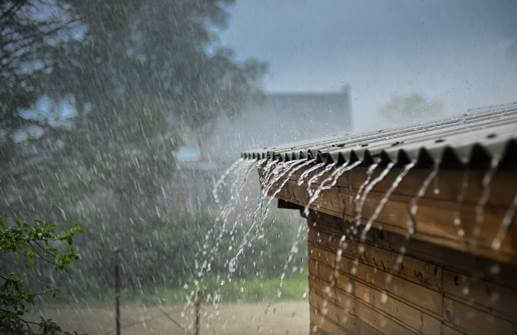Fall in the Pacific Northwest is a beautiful time in many ways. We can take long drives through the Cascades to see the colorful trees in all their splendor, enjoy cool evenings and sunny days, harvest time on the farm, and increasing rains. Did I say the increasing rains of fall were beautiful? Yes, they are, especially if you look at the rain as a resource that you can use.
Amazing Math
One of the most common issues I run into as a farm planner when I go out to help people on their property is the problem of mud. A lot of time the problem is increased by the fact that many barns and other structures lack proper gutters and ways to divert the water away from paddocks and pastures where the mud occurs. It’s always amazing to see the difference it makes to install gutters and downspouts on a barn. But it’s really not that surprising when you do the math.
According to the smart folks at Texas A&M, the amount of rain that the average barn roof captures can be in the tens of thousands of gallons a year! I have been using their formula for years to calculate for landowners the amount of rain that is captured by their barns and structures and it has proven to be very accurate. The formula is actually pretty simple: catchment area (square feet of the footprint of the building) x annual rainfall (in inches) x 0.623 = amount of water harvested (in gallons). If you do the formula for a typical barn of 60 x 100 feet (6,000 square feet) you find that it will catch over 100,000 gallons a year! Even a small 10 x 10 shed will capture almost 2,000 gallons a year.
How much water do I really need?
With all this rain available for use the question now becomes how to capture it and use it in a safe and efficient manner. The first question, though, should be this – how much captured rain do you really need?
When I approach the subject of rain capture, I always do so in the light of how much would you need in an emergency? Winters in the Pacific Northwest can be pretty harsh sometimes and bring storms that will knock out electricity for days or even a week or more. Even if you are on a well, if the power is lost the well pump can’t operate, so you will not have any water. Even if you are on municipal water, a strong earthquake can rupture water lines and shut off your access for days as well. That is why I first look at water needs through the lens of what I will do in an emergency. If I can take care of that question, then anything beyond that is a benefit.
Horses will consume, on average, and depending on breed and size, between 5 and 10 gallons of water a day. If you have other animals on your farm, then you need to consider their needs as well. An average beef cow, for example, consumes one gallon for every 100 pounds of its weight! A goat typically consumes two to three gallons a day and sheep guzzle about five gallons a day. So, add up all your animals and their needs and multiply that by the number of days you anticipate being without water in an emergency (I always suggest counting on 7 days). This is your minimum water needs.
Capture the Resource
The options for capturing the rain are plentiful. You can use rain barrels, cisterns, or a combination of things. One thing to keep in mind, though, is that some counties and states have a limit on the amount of water you can capture at one time, so be sure to check with your local codes to stay in compliance.
I hope you look at the fall and winter rains differently now. They really are a great resource!
See this article in the 2020 October online edition:

Michael is a lifelong student of the horse, from his childhood in Texas ranch country to his work with conservation districts all over Washington State protecting natural resources while also improving the lives of horses and their human companions. Hipp Equine Consulting serves horse owners across the country as well as conducting workshops at local stables on property management, horse behavior, chore management, and many other practical topics.
[email protected]
(425)-314-9980






